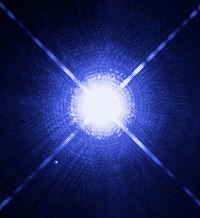
Photo from wikipedia
Abstract We report new light curves of two eclipsing binaries of AV Crb and EK Aqr obtained in 2017 and 2018 using Holcomb and SARA telescopes. We obtain the updated… Click to show full abstract
Abstract We report new light curves of two eclipsing binaries of AV Crb and EK Aqr obtained in 2017 and 2018 using Holcomb and SARA telescopes. We obtain the updated ephemeris and find a continuous period decrease (AV Crb) and increase (EK Aqr), respectively. We used the 2015 version Wilson-Devinney method to analyze the light curves and asymmetries. The effective temperature of the primary components of the two eclipsing binaries are obtained from the Gaia DR2. We determine the orbital parameters of AV Crb and EK Aqr. The secular period decrease of -3.23(17) × 10 − 7 days/yr suggests that in AV Crb mass transfer takes place from the primary component to the secondary at a rate dM1/dt of -3.67(17) × 10 − 7 M ⊙ /yr. We find a hot spot on the secondary component. The orbital period increase 3.33(21) × 10 − 7 days/yr implies that EK Aqr is undergoing mass transfer from the secondary component to the primary at a rate of 3.33(21) × 10 − 7 M ⊙ /yr and we find a cool spot on the primary component. We conclude that AV Crb is a shallow contact eclipsing binary with a contact degree of 19.17(2.45)%, and EK Aqr is a deep contact binary with 56.86(1.13)% factor.
Journal Title: New Astronomy
Year Published: 2019
Link to full text (if available)
Share on Social Media: Sign Up to like & get
recommendations!